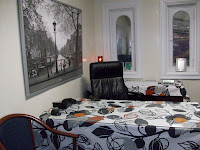 Sometimes, I get a little overeager about things. Nothing really illustrates this more aptly about my latest experiment with barefoot running.
Sometimes, I get a little overeager about things. Nothing really illustrates this more aptly about my latest experiment with barefoot running. See, I'm reading a book called Born to Run, the story of the Tarahumara ultrarunners, who run ultramarathons through canyons in Mexico -- barefoot. And the strange thing about these people? They don't have injuries, depression, heart disease, obesity, or diabetes. They are happy when they run; they are happy because they run.
The point of this study is to bring to light ever-increasing evidence that the tennis shoe is ruining our feet -- and our backs, knees, and ankles -- because it deprives us of our natural pain-sensors. When you put your foot in rubber and foam, it doesn't know the proper way to hit the pavement, so it strikes heel-first and as hard as possible in search of something solid. But when you take off your shoes, your pain-sensors (there as many in your feet as in your groin) tell you to roll your feet from the inside out, to spread your toes wide, to tuck your legs under your hips, and to avoid striking the heel at all cost. People who have tried it have found they no longer suffer pain in their knees, feet, or back -- in part, because we were all (at some point) engineered for running.
So, the more I read of the book, the more stories I heard of people taking off their shoes and suddenly being able to run 80 miles instead of 2. As someone who has been forcing her way through 2 or 3 miles a day for 15 years, I was eager to give it a try.
Totally inspired, I kicked off my tennis shoes and socks. Andrew, wrapped up in my hypothesis, decided to try it, too. Exhilarated, I shot forward onto the pavement and smashed my heel into the ground. My foot instantly corrected itself -- VERY wrong form, it told me immediately -- and I felt my toes spread. I waited for a sensation of flying, of freedom. I waited to feel like I could run a marathon in 15 minutes with nothing on but flip-flops.
Instead? In my zeal, I pounded my pampered, pansy little toes onto the suburban sidewalk, cutting and bruising feet that have never run barefoot and rarely go dirty. I'm brought up short by the sharp gravel I have to cross to get to my driveway. Rather than flying, I'm tiptoeing around the loop in pain. My teenage neighbors look at Andrew and me askance.
"I could've gone much longer!" Andrew says, smiling, apparently unscathed. I hobble past him into the house, to soak my feet.






